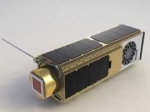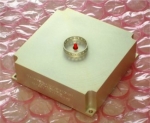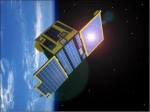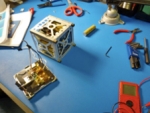Displaying items by tag: small satellite
Innovative Solutions In Space (ISIS)
Innovative Solutions In Space BV (ISIS) is a vertically integrated company with a focus on delivering turn-key solutions based on small space systems (small satellites, CubeSat systems, etc.).
ISI was founded in January 2006 as a spin-off from the Delfi-C3 nanosatellite project from Delft University of Technology in the Netherlands.
QinetiQ Space
QinetiQ Space is a space system integrator.
QinetiQ Space has developed instruments and facilities for scientific research in a microgravity environment, such as material and fluid science research, on both manned and unmanned missions. A lot of these facilities are used on a daily basis by the astronauts in the International Space Station.
QinetiQ Space offers space mechanisms for docking; separation and one-shot opening mechanisms. We have delivered numerous instruments for scientific research for both manned and unmanned missions. Many of these facilities are used on a daily basis by astronauts on the ISS.
In the mid of the nineties QinetiQ Space took the initiative to deploy small satellite activities in Belgium. After the successful launch and demonstration of the PROBA1 satellite QinetiQ Space proved the potential of small satellites for remote sensing applications such as earth observation, environmental monitoring, security and others. Since then QinetiQ Space has established its role as the principal provider of LightSats to the European Space Agency (ESA) by taking up the prime contractor ship for PROBA2 (solar science) and PROBA-V (vegetation) and a key role in the formation flying mission PROBA3.
O/OREOS satellite
O/OREOS (Organism/Organic Exposure to Orbital Stresses) is a nanosatellite of 5.5 kilogram, launched on November 19, 2010.
It is an automated laboratory that contains two separate experiments on board. It has been developed by the Small Spacecraft Division at NASA Ames Research Center, and successfully launched as a secondary payload on a Minotaur IV rocket from Kodiak Island, Alaska on November 19, 2010.
The O/OREOS satellite is NASA's first cubesat to demonstrate the capability to have two distinct, completely independent science experiments on an autonomous satellite. One experiment will test how microorganisms survive and adapt to the stresses of space; the other will monitor the stability of organic molecules in space.
MICROJET Propulsion Module
MICROJET Small Satellite Propulsion Module.
Company: AI: Aerospace Innovation GmbH
Surrey Space Centre (SSC)
The Surrey Space Centre (SSC) is a research centre for Space Engineering. Our strategy is to underpin the technical development of the space industry through its advanced research programmes.
The SCC is specialised for small, low cost space missions, generating leading research and bringing innovation to our spin-out company SSTL and pushing the boundaries of low cost small satellite applications to develop next generation low cost small satellite technologies.
Surrey's pioneering small satellite activities started in 1979 as an academic activity at the University, leading to the formation of a successful spin-out company Surrey Satellite Technology Ltd (SSTL). Astrium acquired SSTL in 2009 and established a long-term strategic collaboration with the University to further advance the University's cutting edge space research capacity.
We provide well focused space engineering undergraduate, postgraduate and industrial short courses, training the next generation space scientists, engineers, entrepreneurs and business leaders.
The SCC academic research laboratories cover advanced multidisciplinary small satellite and space system engineering techniques for Earth orbit and interplanetary space; innovative communications, remote sensing, robotics and space science payloads for small satellites; and enabling technologies for low cost space exploitation and planetary exploration.
Proba (satellite family)
PROBA (Project for On-Board Autonomy) is a family of small Earth observation satellites, part of the ESA's MicroSat program.
Proba-1 was launched by ISRO in 2001. It is a technology demonstrator turned operational Earth observation mission - ESA's smallest, less than a cubic metre in volume. Proba-1's main instrument is the Compact High Resolution Imaging Spectrometer (CHRIS), acquiring 13 square km scenes at 17 m spatial resolution in 18 user-selected visible and near-infrared wavelengths. This agile satellite can also deliver up to five different viewing angles. Nearly 20,000 environmental science images have been acquired. This small boxlike system (40×60×80 cm; 95 kg), with solar panel collectors on its surface, has remarkable image-making qualities. It hosts two Earth Observation instruments (dubbed CHRIS and HRC). It is a hyperspectral system (200 narrow bands) that image at 30 m, plus three in the visible that have 15 m resolution.
Proba-2, the second satellite in the Proba-series, has been launched on November 2, 2009, together with the SMOS mission. Proba 2 is a 0.6 × 0.6 × 0.8 meter, box-shaped structure weighing 130 kg with two deployable solar panels. It has a total of four instruments; two complementary solar observation instruments dubbed SWAP and LYRA, and two plasma measurement instruments dubbed TPMU and DSLP.
Further planned satellites in the Proba series are the formation flight Proba-3 and Proba-V (Proba Vegetation). They are on-going developments without defined launch dates.
Skybox Imaging
Skybox Imaging is developing a high performance constellation of imaging micro-satellites to deliver high resolution imagery of any spot on Earth multiple times per day. Skybox sells timely satellite imagery and derived information products to commercial customers and governments worldwide.
The Skybox team's mission is to expand significantly the use of satellite imagery for commercial customers and governments alike.
Nov 2012: as we approach the launch date of our first satellite, SkySat-1, our team is focused on completing the construction of the satellite and ground infrastructure, as well as building strong relationships with our partners and customers. SkySat-1 is a commercial Earth observation satellite, licensed to collect high resolution panchromatic and multispectral images of the Earth. The satellite will operate in a polar inclined, circular orbit at approximately 450 km above the earth.
Sinclair Interplanetary
Sinclair Interplanetary is a supplier of hardware, software, training and expertise to the spacecraft community.
The primary focus is on low-cost, rapid-schedule programs to produce micro- or nano-satellites. It is based in Toronto, Canada and was founded in 2001.
BLUEsat
BLUEsat, an acronym of Basic Low-Earth-orbit University of NSW Experimental satellite, is a digital amateur radio satellite being designed and built solely by students here at the University of NSW.
The satellite is a small cube measuring approximately 260mm on each side, excluding antennae, and weighs around 14kg. Powered by fixed solar panels on each face, it will carry a flight computer, radio transmitters and receivers, a power-control system, battery packs for when its orbit places it in the Earth's shadow, magnets to passively stabilise the satellite and align it with the Earth's magnetic field, and will be controlled via a dedicated communications groundstation here at UNSW. BLUEsat will be placed in an approximately circular orbit at an altitude of around 750km that will take it over the poles. At this altitude, the satellite will travel around the Earth at a rate of around once every 90 minutes.
BLUEsat is primarily an educational satellite, designed to give students at UNSW space experience which they could not obtain elsewhere.
PhoneSat
NASA's PhoneSat project will demonstrate the ability to launch the lowest-cost and easiest to build satellites ever flown in space – capabilities enabled by using off-the-shelf consumer smartphones to build spacecraft.
A small team of engineers working on NASA's PhoneSat at the agency's Ames Research Center at Moffett Field, Calif., aim to rapidly evolve satellite architecture and incorporate the Silicon Valley approach of "release early, release often" to small spacecraft.










